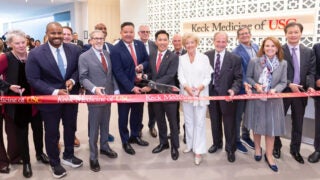New USC hires make an impact
A newly recruited team of biochemists is poised to disrupt the future of pharmaceutical development and advance personalized medicine
Though their future home remains under construction, a team of high-profile scientists recruited to USC has wasted no time since arriving on campus earlier this year, launching an ambitious campaign to address “impossible” health challenges.
From their temporary digs at the northwest corner of campus, the scientists of the Bridge Institute at USC (The Bridge@USC) have published a half-dozen highly cited papers in top scientific journals such as Science, Nature and Cell.
The papers outline their successes in mapping the structures of the bodies-signaling receptacles called G protein-coupled receptors (GPCRs), which act as the gatekeepers to cells — controlling signaling through the cell membrane that drives physiological response to outside stimuli.
Understanding and targeting GPCRs could pave the way for cheaper pharmaceuticals that cause fewer side effects.
“By supporting this work, USC is tackling a problem that faces every person across the globe. We envision a future in which effective pharmaceuticals with minimal side effects are affordable to everyone. And our researchers see a way to make that a reality,” said Randolph Hall, USC vice president of research.
“Since arriving at USC in January, we have accomplished a tremendous amount and this is only the very beginning,” said Raymond Stevens, Provost Professor of Biological Sciences and Chemistry at The Bridge@USC. Stevens was recruited to USC during summer 2014 with Professors Vadim Cherezov, Seva Katritch, Peter Kuhn, Jim Hicks and roughly 50 colleagues who collaborate with researchers from a variety of disciplines across campus.
GPCR structures
The human body is controlled by more than 800 GPCRs, representing the largest family of proteins in the human genome. After 20 years of work, scientists managed to solve their first GPCR structure eight years ago. Since then, they have solved about 30 additional unique human GPCR structures, a feat made possible only recently by improvements in technology that includes high-energy X-ray lasers.
In just the first six months of 2015, Stevens, Katritch, Cherezov and their colleagues have mapped the structures of five novel human GPCRs, offering new insight into the mechanisms behind hypertension, addiction and vision — all while awaiting the construction on the future USC Michelson Center for Convergent Bioscience. The Michelson Center, slated to open in September 2017, is a state-of-the-art facility made possible by a $50 million gift from philanthropist and retired orthopaedic spinal surgeon Gary K. Michelson and his wife, Alya Michelson.
Morphine and its cousins
When you see something with your eyes, it’s because photons of light interacted with GPCRs on the cells in your retina, translating electromagnetic radiation into a cellular signal for your brain to interpret.
When your heart starts racing with fear or excitement, it’s because the hormone adrenaline interacted with a type of GPCR known as an adrenergic receptor to trigger responses in your nervous system. And when you take a pain reliever like morphine, you feel better because the drug interacts at a molecular level with a GPCR called a ?-opioid receptor that tells your cells to stop sending so many pain signals to your brain.
That last example, in particular, illustrates why GPCRs are a favorite target of pharmaceutical companies, but also why it’s critical to have a deep understanding of GPCRs when targeting them.
Morphine and its cousins, opium and heroin, have been around for centuries, but they are as well known for their addictive qualities as for their pain-relieving powers. That’s because the GPCR ?-opioid receptor not only blocks pain signals, it triggers physical dependence.
It pays to know exactly how a GPCR is structured down to the atomic level so that pharmaceutical companies can design drugs to interact with them in specific ways.
But even with the latest technological advances and the urgent interest of academia and industry alike, the pace of cracking the GPCR code has been slow. It costs an estimated $1 million to $5 million to solve a single structure and takes about one to five years.
That may sound expensive, but compare it to the normal cost of designing a drug. Typically, pharmaceutical companies and researchers employ a high-throughput trial-and-error approach, minutely tweaking small molecules and testing each iteration to see what will work.
A 1 in 5,000 success rate
It’s not entirely a shot in the dark — the families of molecules that are tested are selected carefully — but the process still only has a 1 in 5,000 success rate at a cost of about $1.2 billion to bring a drug to market.
Still, in the face of dwindling federal research funding, spending $1 million to $5 million to solve a single GPCR is a tall order for research institutions. And though it beats the alternative, for pharmaceutical companies, it’s still a major risk to take.
That’s why the Bridge@USC is now also the hub of an industry-academia open-source consortium that uses public-private funding to solve the structure of GPCRs.
The effort is spearheaded by Stevens, who launched the International GPCR Consortium last October. The nonprofit group includes nine pharmaceutical companies (Amgen, Sanofi-Aventis, Novo Nordisk, Merck & Co., Pfizer, Lundbeck, Taisho, Boehringer-Ingelheim and Ono) and three research institutions (Bridge@USC, Shanghai Institute of Materia Medica and the iHuman Institute at ShanghaiTech University).
The consortium is a marriage of related interests designed to jump-start research into the gatekeepers of cells, leading to more effective, cheaper pharmaceuticals that have fewer side effects.
Common scientific goals
It has been wonderful to see industry and academia working together to accomplish common scientific goals.
Raymond Stevens
“It has been wonderful to see industry and academia working together to accomplish common scientific goals,” Stevens said. “Industry has a wealth of knowledge, particularly around the chemistry of these human receptors. Not only are we breaking down barriers or silos between academic disciplines, but we are also breaking down barriers between academia and industry.”
The consortium breaks up the cost, risk and effort needed to solve GPCRs and makes the findings publicly available through an open-source format, in addition to peer-reviewed research articles.
The pharmaceutical companies help fund the management and provide compounds for different GPCRs, identifying which GPCRs would be the most impactful together with the academic groups. The public-private open source consortium plans to target GPCRs that affect diabetes, cancer and mental disorders — with the goal of being able to model the entire human GPCR superfamily of more than 800 different receptors within the next five years.
“As for the Bridge Institute at USC, we will use the knowledge from these studies and integrate the data with other labs for an improved understanding of the complete human body so that we see a real convergence of disease diagnostics and medicine development,” Stevens said. “The main goal at The Bridge@USC is to understand the complete human body at the atomic level and improve the human condition.”



